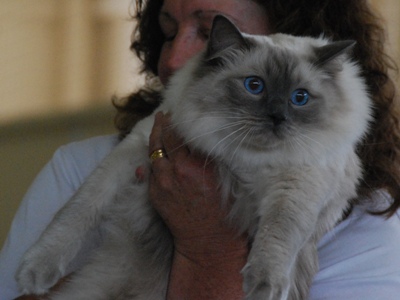History of the Ragdoll
In the early
'60s a woman in Riverside, California, by the name of Ann
Baker created the RAGDOLL by breeding what was
believed to be a white female Persian-type cat to a Seal
Point Birman. One of the male offspring from this breeding
was then bred to a female Burmese. This was the foundation
for the Ragdoll.
The above paragraph states what most Ragdoll breeders
believed were the beginnings of the Ragdoll for many years.
However, more recent investigations lead us to believe that
the Ragdoll's beginnings were somewhat different. The
following is taken from the book The Definitive Guide
To Ragdolls by Lorna Wallace, Robin Pickering and
David Pollard, published by Ragdoll World UK.

At the time Ann had
been borrowing one of Josephine's older sons to sire progeny
in her Black Persian breeding programme. This son had the
appearance of a Black/Brown Persian and she named him
Blackie, and it was one of her visits to borrow him that she
saw Blackie's brother. He appeared most impressive and in
Ann's words had the appearance of a Sacred Cat of Burma,
(The Birman Breed). Having already established the owner's
trust, she was also permitted to borrow this cat to mate
with her own females. She was most taken with this son of
Josephine and named him Raggedy Ann Daddy Warbucks. What Ann
clearly states is that Blackie and Daddy Warbucks are both
sons of Josephine, but with different sires. In the IRCA
booklet it would appear to indicate that Blackie's father
was a black cat from the East, that appeared more Persian
than Burmese. During detailed questioning, Ann confirmed
that no-one had ever seen the father of Daddy Warbucks, and
he was the only kitten in that particular litter of
Joesphine's. This being so, makes it difficult to take the
origins of the breed further.
The RAGDOLL was first recognized as a pure
breed in 1965 by NCFA (now defunct). Following that
achievement Ann did nothing to further the Ragdoll
in the fancy. Fortunately, a new breeder husband and wife
team bought a pair from Ann and realized the breed had to be
shown and accepted by the various associations in the fancy.
RAGDOLLS are accepted today in all
associations. However, some Associations do not allow
Ragdolls in certain patterns to compete.

The beauty of the RAGDOLL is only one of their
many features. Their disposition and personality are what
makes them a truly unique cat. They are quiet, playful,
placid, relaxed and very loving. They make a wonderful house
or apartment cat. Becuase they posses a non-fighting
instinct, a RAGDOLL should never be left
outside unattended. They can be easily leashed trained.
RAGDOLLS are docile, large and affectionate and
respond well to children and other pets. RAGDOLLS
are slow to mature physically obtaining full maturity
between 3 and 4 years of age. Altered adult males may reach
15 to 20 pounds, females will weigh about 5 pounds less. The
RAGDOLL's fur is rabbit-like, medium long with
little shedding. The RAGDOLL requires little
or no routine grooming. All RAGDOLLS have
beautiful blue eyes
|